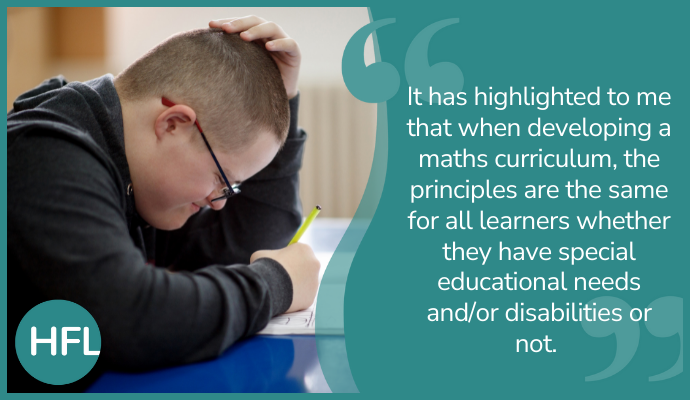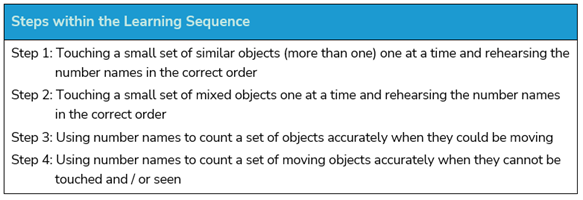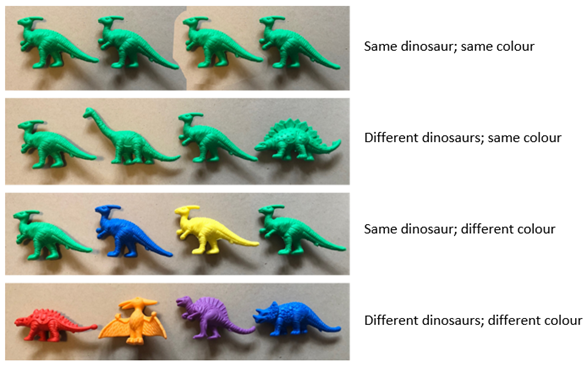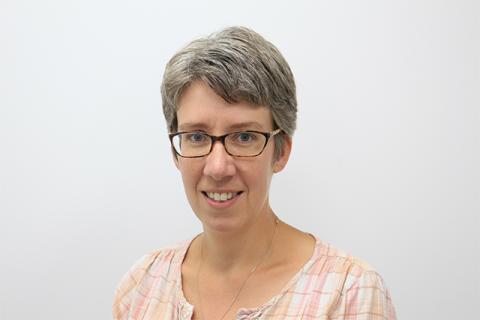
I have the privilege of working with many schools across Hertfordshire and over the borders into other areas too. As you may or may not be aware, the HfL Education Primary maths team spend most of our time working in schools with children, teachers, and subject leaders to support the implementation of the maths curriculum.
Our work includes everything from working with individual children to develop their mathematical learning, to team teaching with teachers to look at pedagogy in maths lessons, action planning and monitoring with maths subject leaders and maths curriculum development. As you can see, everything to do with maths! We work with schools regularly over longer periods of time, so we get to know them well, so our support is bespoke.
This means, using Ofsted speak, we support schools with the ‘3 Is’ of their maths curriculum; their intent, implementation, and the impact.
In this blog, I would like to tell you about the journey I am currently on with two of my schools that offer special provision for pupils with special educational needs and disability (SEND).
Southfield is a primary school for approximately 80 pupils with Learning Difficulties, which include, Autism, Speech Language and Communication Needs, Global Developmental Delay and other conditions.
The secondary school is an academy for 11–16-year-olds who all have Special Educational Needs. Traditionally a school for pupils with learning difficulties, they were recently designated as an LD, ASD and SLCN school by the local authority. Pupils have a range of needs including ASD, Global Developmental Delay, Downs Syndrome and rare specific diagnoses.
The secondary school, I have been working with since 2019 and Southfield since Easter 2022.
I should say at this point that my role in supporting these schools is focused on curriculum and pedagogy; not the pupil’s learning needs. I am fortunate to have worked with many children across my teaching career with a range of special educational needs and disabilities who have helped me to have some understanding of teaching for a range of learning needs. Both schools have the goal of developing their maths curriculum and it is for this that they want my advice.
If we refer to the ‘Quality of education’ section of the Education inspection framework, it says:
Inspectors will make a judgement on the quality of education by evaluating the extent to which:
Intent
- leaders take on or construct a curriculum that is ambitious and designed to give all learners, particularly the most disadvantaged and those with special educational needs and/or disabilities (SEND) or high needs, the knowledge and cultural capital they need to succeed in life
- the provider’s curriculum is coherently planned and sequenced towards cumulatively sufficient knowledge and skills for future learning and employment
Guidance, Education inspection framework
Updated 11 July 2022
With both schools, we started with thinking about developing a curriculum that is coherently planned and sequenced. Maths learning is hierarchical. I see it as an interconnected spiral, building upwards in small steps; new learning builds and is connected to what has come before.
For both schools, it was agreed that the ESSENTIALmaths resources, produced by the HfL Education maths team, would be a good place to start as these resources have been very carefully designed to build and connect the learning. However, I was very conscious, particularly for the secondary school, that to avoid it being like putting a square peg in a round hole, the resources would need adapting.
We knew that to meet the needs of lots of the learners, the small steps within the planning materials could be too big or could take too long. Ways to tighten the spiral were discussed.
Tightening the spiral
Here are the sequenced steps from the first two learning sequences from the Reception ESSENTIALmaths learning sequences:
Subitising (including equivalence, more and less)

Counting Skills (stable order and one to one correspondence)

The number range within the first learning sequence is between 1 and 6. In the second sequence, the range increases to counting within 10.
The steps in these sequences are already small and the number range is within the first decade but for some learners at these schools, without tightening the spiral, it could either mean that learning moved on too quickly and wasn’t secured or they would be learning the same thing for a very long time.
So, to tighten the spiral, these possible changes could be made:
Reduce the number range
- In the first sequence, initially secure subitising to 3
- In the second, keep the count to 5
Adapt the steps
- In the first sequence (in steps 3 and 4), the size of the objects within the groups of objects being subitised varies. Exploring this requires a secure understanding of conservation of number so initially comparing sets of the same sized objects would still enable the pupils to notice when values are the same or different without adding the extra challenge of size.
- In step 2 of the second sequence, mixing the objects in the set being counted could be built up in smaller steps. The sets could contain objects of the same type (for example, dinosaurs) with small changes being made to the sets being counted each time.
For example:

Postpone steps
- In both learning sequences, the final steps focus on subitising or counting when objects are moving or can’t be seen. Initially, these steps could be removed.
This doesn’t mean that the adapted learning would be not completed; these learning sequences would be revisited and then expanded to include all aspects of the learning within the original steps.
The next learning sequence in the progression focuses on comparing and developing the language of measure. Aspects of this could be taught and then the learning can loop back to the first learning sequence. The spiral is tightened and revisited without learning being missed or dragging on for too long.
Considering progression
The ESSENTIALmaths resources are written to match the Early Years Framework and National Curriculum expectations for Reception through to Year 6. This was another aspect of discussion as, in both schools, the pupils are not working at age-related expectations due to their special educational needs and/or disabilities. Also, in the secondary school, pupils are not within the primary age range.
In addition, in both schools, classes are organised considering pupil needs, rather than by age, meaning that pupils are not always with peers of the same age. Identifying starting points and then year-on-year transitions is an area that still needs to be ironed out.
Despite this, staff can now see the progression in maths more clearly using the steps within the sequences. The models provided, particularly of the talk, support their teaching and there is a greater consistency of mathematical models and language being used.
Developing subject knowledge
Another part of my support with both schools has been developing the staff’s subject knowledge.
In the ‘Quality of education’ section of the Education inspection framework, it says:
Inspectors will make a judgement on the quality of education by evaluating the extent to which:
Implementation
- teachers have good knowledge of the subject(s) and courses they teach. Leaders provide effective support, including for those teaching outside their main areas of expertise
- teachers present subject matter clearly, promoting appropriate discussion about the subject matter they are teaching. They check learners’ understanding systematically, identify misconceptions accurately and provide clear, direct feedback. In doing so, they respond and adapt their teaching as necessary, without unnecessarily elaborate or differentiated approaches
- over the course of study, teaching is designed to help learners to remember in the long term the content they have been taught and to integrate new knowledge into larger concepts
Guidance, Education inspection framework
Updated 11 July 2022
In both schools, the teaching of the curriculum is organised so that most subjects are taught by a single teacher. As a primary teacher myself, I see myself as a ‘Jack of all trades, and a master of none...’ I don’t see this as a negative, but I appreciate that I am not a specialist in a single area – I always have found I have greater aptitude for some subjects than others – I know I was never great at teaching PE or modern foreign languages, but I felt more confident with maths (unsurprisingly, due to the job I do now), science and art.
This meant that in both schools, like in most schools, there were varying degrees of subject knowledge and confidence in teaching maths across the school staff. Therefore, staff CPD has been, and continues to be, an important part of my role.
For both schools, training has been given to all staff on maths subject knowledge, particularly early maths concepts such as counting, subitising, ordering and comparing numbers, all of which support the teaching and learning of a sense of number. With all children, it is important that there is a deep understanding of these early number concepts because it is upon this all maths is built.
Memorisation and recall can sometimes mask whether this is understood or not. This can lead to some pupils being able to recall individual bits of information from long term memory but being unable to connect it to new learning or apply it.
The Deputy Headteacher of Southfield School reflected about the impact the training has had on staff:
“The CPD has definitely been impactful, with staff gaining the knowledge to teach early maths. I have never heard the word subitising used so often. It has made us think about the depth of knowledge as a building block rather accepting that if a child can count to 100, they understand about those numbers.”
Investing in professional development
Other ways in which the leaders at both schools have supported the staff to deliver the curriculum is to invest in specific training to implement and use the ESSENTIALmaths resources well. Teachers across both schools have had access to a mixture of online and face-to-face training. This has enabled them to understand how the resources can be best used to support understanding and delivery of the curriculum.
My work within the schools has included working directly with all class teachers to see how the resources can be adapted further to meet the needs of their learners. This is still very much a work in progress at the primary school as the resources are still very new, and time is needed to become familiar with them and to embed their understanding.
Developing independence and confidence
One thing we have recognised is that the curriculum is vast, and we must not lose sight of the overarching aims. At both schools, their goal is to develop the children into young people and adults who are independent, confident, and ready for their next steps.
Many of the pupils at these schools, like many pupils who attend special schools, will not leave school with same qualifications as their peers – GCSEs, A levels etc. At the secondary school, they have introduced assessments and qualifications that reflect the life skills that their pupils will need.
Together, we have started to map the knowledge and skills needed to complete the assessments and gain the qualifications, planning this into the ESSENTIALmaths progression. An outcome of this is that the progress through the curriculum as it stands will need reviewing; elements enhancing, and other aspects being removed or thinned out. Now that staff have been using the resources for a period of time and are more familiar with the progression as it stands, this is one of our next areas of development.
Purposeful assessment
Assessment across both schools is developing through teachers having a better understanding of the progression of the curriculum and having continued professional development. They are growing in confidence with formative assessment.
The secondary school have used multiple choice diagnostic assessments that have helped them identify starting points and quantify the security of the learning. In addition, due to the incorrect answer choices being carefully chosen, they have also exposed gaps and misconceptions. This means that future planning can be further adapted to address this.
In the Education inspection framework under Implementation, it says:
Inspectors will make a judgement on the quality of education by evaluating the extent to which:
- teachers and leaders use assessment well, for example to help learners embed and use knowledge fluently or to check understanding and inform teaching. Leaders understand the limitations of assessment and do not use it in a way that creates unnecessary burdens for staff or learners
Guidance, Education inspection framework
Updated 11 July 2022
The increased confidence in subject knowledge and having a clear progression in the curriculum, alongside assessments that inform planning and teaching, means that practice is developing to use assessment more effectively to inform teaching. Ways to track and monitor the small steps of progress at a whole school level is a challenge and still on the ‘to do list’.
Reflections
In writing this blog and reflecting on my work with both specialist provision schools, it has highlighted to me that when developing a maths curriculum, the principles are the same for all learners whether they have special educational needs and/or disabilities or not.
The intent of the curriculum needs to be clear, so pupils learn the mathematical skills and knowledge to achieve well. But in these special schools, the focus isn’t so much on data-based outcomes at the end of Key Stages; it is more focused on making sure that the pupils have the life skills and knowledge that ensure that they are ‘ready to take their place in 21st century Britain’, as David McGachen said in his Headteacher Welcome on the school website.
In my opinion, widening out our range of vision for what our maths curriculum is driving towards is a good thing (I am not naive enough to know it isn’t a huge challenge in our current system).
Broadening the horizons so it isn’t all about outcomes, percentages, and progress scores would help us see the purpose for maths in all aspects of life and more people might have a more positive view of the subject.
Nevertheless, tightening the focus on learners’ needs, would be a good thing, particularly those who have greater vulnerabilities or special educational needs and/or disabilities. Thinking carefully and deeply about how the teaching and learning can be broken down, scaffolded, and taught in those small steps so the skills and knowledge learnt is secure and can be applied is absolutely what is needed for the pupils at the schools I have talked about in this blog. But wouldn’t this be good for all pupils, whatever their needs?



